Posted by OromianEconomist in Africa, African Literature, Ancient African Direct Democracy, Ancient Egyptian, Ancient Rock paintings in Oromia, Ateetee, Ateetee (Siiqqee Institution), Black History, Chiekh Anta Diop, Culture, Cushtic, Humanity and Social Civilization, Irreecha, Irreecha (Irreesa) 2014, Irreecha (Irreessa) 2014, Irreecha Birraa, Kemetic Ancient African Culture, Meroetic Oromo, Oromia, Oromiyaa, Oromo, Oromo Culture, Oromo Identity, Oromo Nation, Oromo Social System, Oromo Wisdom, Oromummaa, Qaallu Institution, The Goddess of Fecundity, Waaqeffanna (Oromo ancient African Faith System).
Tags: Africa, African culture, African Studies, Ateetee, Gadaa System, Irreecha, Oromia, Oromiyaa, Oromo, Oromo culture, Oromo people, Oromummaa, Qaalluu, Waaqqeffannaa: Oromo ancient Africa's faith System
In most of Africa, indigenous African religions have been pushed to the margin because of a number of factors. The implied and open relegation of indigenous African religions to the levels of inferiority and inconsequentiality in world affairs by colonial powers and post-colonial contemporary African states not only undermines and stereotypes the examination of the unique contributions of these religions to peacemaking, but also discards with them unique mythologies, values, laws, cultures and meaning-making systems. I argue that applying North American conflict resolution models, without considering African religious values that existed for many millennia before the arrival of world religions, will be an enormous hindrance to building lasting peace from the bottom-up in the vastly rural and agrarian Africa that is still steeped in traditions and rituals.
Contributing to a range of negative stereotypes about African religions (example, uncivilized, barbaric and conflict-generating) is the fact that many of them have been orally transmitted from generation to generation and lack written major holy books unlike the world religions. The purpose of this paper is to shift attention from common misconceptions about African religions to a productive examination of the constructive roles they can be made to play.
I will focus on the case of Waaqeffannaa, an Oromo indigenous religion of East Africa, and its core values and laws. It will be significant to examine Waaqeffannaa’s complex concepts, such as concept and view of Waaqaa (God), Eebba (prayers and blessings), safuu (the place of all things and beings in the cosmic and social order), issues related to cubbuu (sin) and other religious and ritual practices. Although there is no holy book forWaaqeffannaa thus far, I will obtain my data from published ethnographic books, journal articles, periodicals, relevant reports and press releases. The interactions between Waaqeffannaa and other organized religions, such as Christianity and Islam, will be examined in context.
The paper will seek answers to three related questions:
What are the contributions or lack thereof orally transmitted values and laws of Waaqeffannaa to peacemaking and relationship-building? If there are any contributions, how can they be compared to other forms of conflict resolution? What will be the role of Waaqeffannaa in peacemaking in the ever changing global and local contexts of religious diversity and difference?
The Concept of God in Waaqeffannaa’s Monotheistic System
In order to examine the hermeneutic advantages and disadvantages of Waaqeffannaa and compare it to modern or Western conflict resolution methods, it is essential to examine the concept of God (Waaqaa) in the religion in its own right. There is a consensus among researchers and observers of Waaqeffannaa—the most prominent of whom are pre-colonial European missionaries, explorers and anthropologists and local religious leaders and scholars—that Waaqeffannaa is one of the ancient indigenous African monotheistic religions.[1] The Oromo, the Cushitic African people of Ethiopia, among whom this religion emerged and developed, call their one God Waaqaa or more intimately and endearingly Waaqayyoo (good God). It is difficult to capture with one definition the complexity of the ways in which the followers of this religion (Waaqeffataas) relate to God and make sense of God (not gendered) is hard to capture just with one definition. The question of ways of understanding and relating to God is a question of Waaqeffannaa’s worldview that is indigenous and unique, in some ways, and thus, different from ways in which followers of major world religions understand and relate to God.
While monotheism is a key similarity it shares with Judaism, Christianity and Islam, Waaqeffannaa has the following worldview of its own:
We believe in God who created us. We believe in Him (sic) in a natural way … We believe in God because we can see what God has done and what he does: he makes rains and the rains grow greenery, and crops that we consume. He lets the sun shine. So believing in him is instinctive and inbuilt. It is as natural as the desire we have for food and drink, and as natural as the reproduction of living things. We go to the nature, the nature that He created: mountains and rivers to praise and appreciate Him impressed by His works … [2]
This contemporary declaration of the faith centers on nature and creation that can be pragmatically seen and experienced in daily life. There is no mention of “heaven” and “hell” here. Concerning the followers’ perceptions of the residence of God, Bartels writes, “They do not visualize Waaqaa(sic) existing outside this world in time or space … In this sense Waaqaa is as much of this world as the vault of the sky.”[3] Bokku concurs with Bartels findings that God exists among people on earth, but Bokku makes a radically different claim as follows: “Waaqeffataas don’t [sic] believe in after life. They don’t believe that God would come in the future to judge people and send the righteous to heaven and the sinful to hell. God is with us always.”[4] Bokku’s claims can be controversial because in much of the literature I reviewed, I found that the question of “after life” is either overlooked or ambiguously treated, except in the work of Father De Salviac whose much older field research (1901) explicitly states the existence of the belief in life after death among Waaqeffataas in eastern Oromia as follows:
They acknowledge three places destined to receive the souls after death. The paradise, which they call: the ‘Happiness of God’,Ayyaana Waaqaa; or the: ‘Response of God’, Bayanacha Waaqaa; or even Jenneta Waaqaa; ‘Paradise of God’, is reserved for the just who go there to enjoy the company and infinite blessings of the Lord … they say of death ‘That he passed on to Waaqaa;’ – ‘That he entered into Waaqaa,’ – ‘That he went to his eternal house with Waaqaa’.[5]
Reference to life after death, punishments and rewards in hell and heaven respectively are very rare features of the religion. Nonetheless, the argument that De Salviac makes about the existence of the belief in life after death in Oromo society is enough to make Bokku and other writers’ denial of the existence of “life after death” contested and curious. The issue of justice and how people relate to each other may hold for every writer. The question of relationships between peoples, and nature and justice will be treated in later sections for safuu.
Waaqeffataas generally view and worship Waaqaa based on their amazement with the ingenious works of Waaqaa’s hands that they experience and find them overwhelming to comprehend and explain. Even family prayers around the hearth contains many such instances: “UNIQUE AND SO GREAT GOD SUPPORT WITHOUT PILLAR THE DOME OF THE BLUE SKY.”[6]
Waaqeffataas view the earth as one of the major ingenious works of God. The earth is viewed inseparably from God. The image that followers of this religion have of the relationship between Waaqaa and the Earth “comes close to that of a human couple”[7]: ‘the earth is Waaqaa’s wife—Lafa niti Waaqaa,’[8] According to Bartels, there are four manifestations of the close connection between Waaqaa and the earth in four spheres of theWaaqeffannaa religious life:[9]
- Blessings
May the Waaqaa and the earth help you.
May Waaqaa and the earth cause you to grow up (a blessing for children.) …
- Curses
Be not blessed either by Waaqaa or the earth.
May Waaqaa and the earth burn [make dry] your kidneys and your womb (the curse is addressed to a woman).
- Oaths
The man who takes the oath breaks a dry stick, saying:
‘May the earth on which I walk and Waaqaa beneath whom I walk do the same to me, if I have done such and such a thing.’
- Rituals
There are rituals of slaughtering a bull or sheep for Waaqaa and making libation (dhibayyuu) under a tree for the earth.[10]
Waaqeffannaa rituals honor both God and the earth. Followers of the religion seem to take cue from God Himself, who created the earth, to inform their ways of relating to Waaqaa and earth (lafa). Evidence that suggests a relationship based on fears, intimidations or punishment between God and persons is less prevalent than those that are mostly based on respect for God, one another and for the earth. Waaqeffataas embrace and celebrate the egalitarian view of God and the diversity of names people call God. Despite some differences among people, research points to followers’ similar attitudes towards God. “… it has become clear that their attitude towards him [sic] is not only inspired by awe but also marked by familiarity and even, from time to time, by lack of respect. In his despair, a man may claim: ‘Waaqaa does not exist!’”[11] This just showsWaaqeffataas have a more liberal relationship with God. It does not mean that they are less pious as there is enough evidence to suggest many magnificent examples of humility, piety and obedience.
The question of Waaqeffataas’ acknowledgement of the oneness of God and the multiple names various religions call Him does not only show the openness of the concept of God to various interpretations, but it also shows the religion’s acceptance of religious diversity. It is easier to engage in interfaith or other conflict resolution activities when such an acknowledgement is extant than when religions claim “my way or the highway.” The ways some prayers are rendered testify to this progressive values of Waaqeffannaa: “O Black God who created the dark sky and the clean waters, who is one but called by multitudes of names, who has no competitor, the omniscient, the omnipotent, the omnipresent, who is eternal and ever powerful, whose power can never decline.”[12] Because of the view of God described here, Waaqeffataas believe that God is patient and that it is not in His nature to become angry if people believe in other things abandoning Him. Bokku holds the Waaqeffannaa God is too self-confident to be angered into punishing people who do not obey or defect to other religions.[13]
Prayers and Blessings
Boran society sometimes appears to float on a river of prayers and blessings…
— Paul T. Baxter.[14]
Common to private, collective and family prayers is the focus of Oromo/Waaqeffataas’ prayers on the material conditions and well-beings of the self, the family and the group. Prayers mediate conditions of people to God so he can intervene and alter their current conditions.[15] The faithful pray for peace, health, deliverance from wrongdoing and harmful sprits and things, human and livestock fertility, growth of babies (little ones), long life for adults, for the goodness of the inside and the outside, rain, harvest and development, inter alia.
The Waaqeffannaa prayer is barely about inheriting the kingdom of heaven nor is it about seeking the help of God in a battle against Satan and sin. Evidence suggests that the concept of Devil/Satan does not exist in Waaqeffannaa while spirits that cause all kinds of suffering and misfortune or harm (ayyaana hamaa) are believed to exist.[16] Instances of talk about Devils by Waaqeffataas are generally understood as the borrowing of a religious vocabulary from the adjacent/co-existing major faiths, such as Christianity and Islam. For instance, Waaqeffataa pray to God to prevent them from wrongdoing and errors committed in ignorance. The religion has no room for addressing anxieties and fears arising from the imaginary realm of the devil/evil. For instance, words used in prayers include, “Prevent us from wrongdoing …” (dogogora nu oolchi). In terms of how people experience and understand misfortunes and fortunes (good things) Oromo proverbs capture the peoples’ dependence on Waaqaa. Indeed, the proverbs below indicate how Waaqaa is perceived as the source of good and bad things that happen in real life:[17]
A house that is built by Waaqaa will be completed.
It is Waaqaa who brings hunger;
It is Waaqaa who brings a full stomach.
The one Waaqaa clothes will not go naked.
Who trusts on Waaqaa will not lack anything.
Man wishes, Waaqaa fulfills.
Waaqaa is there [therefore] the sun rises.
It is Waaqaa who makes a person sick;
It is Waaqaa who restores him to health.
Waaqaa is never in a hurry;
But he is always there at the proper time.
There are standard prayers that have been codified in oral tradition and bequeathed down to generations. The codification of prayers, rituals and ceremonies in oral traditions serve the purpose of making Oromo worships definite and unarbitrary. The question of precise transmissions of spoken messages are always up for debates as there are obviously some room for improvisation and modification as the word of mouth (message) travels through time and space. I believe that the improvisation aspect of oral narratives will add an interesting dimension of dynamism to the hermeneutics of Waaqeffannaa.
De Salviac praises the endurance of Waaqeffannaa for many millennia in spite of the oral mode of transmission. De Salviac aptly critiques the West for generally believing that the sole sources of “valid” or “authentic” knowledge are written texts (books) as follows: “We, accustomed to the cycle of knowledge by turning pale over the books, our careless memory resting on the permanence of typography, we hardly take into account the power of tradition, which sufficed, for centuries, for the civilization of many peoples. With the Oromo, religious and secular traditions are formulated in thousands of short sentences …”[18]
What I understand from De Salviac is that Western or modern industrialized societies privilege written knowledge. His critique is on tangent because preference for written and formal communication in the West will certainly shape intervention policy-making, official diplomacy and the attitudes of interveners towards indigenous cultures. Third party interveners with fixed or rigid approaches are not only likely to disrespect and shun local knowledge systems, but they are also likely to impose rigid and unproductive conflict resolution processes developed in the context of limited civilizations.
One can only anticipate the stiff resistance that locals are likely to put up against Western models in today’s Africa where there is an increasing awareness about the importance of self-reliance and going back to the roots in order to solve indigenous problems. The true superficiality of strict Western models of dialogue, mediation, problem-solving workshop can be revealed by observing how in most of Africa’s peripheries cut of modern laws, bureaucracies and infrastructures, people thrive on the strong indigenous knowledge systems. This is how most conflicts are resolved and how people do communal work in either irrigating the land or protecting the environment. In the contexts of corrupt and partisan politics, these efforts by local people to overcome the daily challenges must be given credit because some of them are providing themselves important social services that that their governments have failed to provide them. In any effort of conflict resolution or peacemaking in such dire circumstances, it is imperative to bring local knowers (the wise men and women) into the sphere of diplomacy and peacemaking.
Prayers, sometimes synonymously called blessings or benedictions, in the form of litany and chants are integral parts of indigenous communities. Every communal activity whether it is weddings, funerals or dances and music begins with blessings or prayers. Eebba is aimed moderating the way people relate to each other at certain venues and beyond. They are about building constructive relationships even in times of wars. Here are some examples of Oromo prayers/blessings of different periods and crowds’ responses.
Pre-colonial prayers[19]:
Ya Waaq, have pity on us; Yes, yes, have pity on us
Ya Waaq, bless us; Yes, yes, bless us.
Ya Waaq give us happy days; Yes, yes, happy days.
…
Ya Waaq in our discussions inspire us; Yes, yes, inspire us.
Ya Waaq in our counsel give us light; Yes, yes, give us light.
Ya Waaq bring back rebellious son to his father; Yes, yes, bring back.
Ya Waaq bring back unruly son to his mother; Yes, yes, bring back.
…
Ya Waaq to good man give cows; Yes, yes, give.
Ya Waaq preserve our house from ruin; Yes, yes preserve.
…
Contemporary prayers:[20]
Yes! Yes! Yes!
God of Nature and of Creations;
Waaqaa who created the Haroo Walaabuu (lake)[21];
…
Waaqaa who let us spend the night in peace;
Let us spend the day in peace;
Prevent us from entering into fatal errors;
Guard us against straying from the right path;
Guard us against mistakes/wrongdoings;
May the Creator we pray to hear us!
May Waaqaa guard us against the harmful!
May Waaqaa bring good things our way!
May children (the little ones) grow up!
May the grown-ups live longer!
May the ignorant know!
May experts/the wise last!
May Kormaa (uncustrated bull) reproduce!
May pregnancies stay healthy and hold!
Let Him keep away harmful things!
Gadaa (social system) is the system of rain and peace!
The year is the year of abundance/development and full stomach.
These contemporary prayers cited from the Waaqeffannaa magazine are powerful. They are usually used in order to open any public/communal gatherings secular and spiritual. This is how things are called to order. The religious prayers give authority or credibility to whatever event that is to take place. At the center of this messaging is reaching the hearts and minds of parties to an event by cleansing the air of any hard feelings and ensuring that the heart and minds are softened and ready for the secular or non secular events and exchanges that will proceed from that.
Historically, Oromos made ecumenical pilgrimages to holy sites of Abbaa Muudaa, Spiritual Father,[22] in order to receive blessings for them and to bring back blessings into their communities with them. Blessings are still considered serious religious activities that serve as glues of social life. Spiritual Fathers can give blessings to people on a range of personal and communal matters: such as long life, being alive, more property and wealth, peace in the household, on productions (calves, children, crops).
I have not come across modern mediation, negotiation or other third party intervention processes that start with prayers. Obviously, if blessings are not built into the processes, an attempt at conflict resolution in African societies, such as the Oromo, will be in vain. In the first place, people will not recognize what is not authorized and endorsed by their own knowledge system. Most importantly, empowering and funding Abbaa Mudaas or elders to engage in conflict resolution is likely to be accepted and bear fruit because of the tremendous reputations these people wield in society. They are highly regarded in society and leaving them out of official processes simply works against peace.
In Waaqeffannaa, one sees from the content of the payers and blessings above that most of them take on the nature of what Gopin succinctly characterizes as “Premordial prosocial moral/spiritual values.”[23] Although many of the conflicts in Ethiopia (Africa) are not religiously driven, the application of religious values will have a huge impact on conflicts driven by ethnicity, nationalisms and competition over resources and power. People listen when one reaches out and talks to them at their own level. Gopin provides a detailed critique of why current modern conflict resolution approaches fail to understand the importance of using prosocial religious values in the context of the Arab/Israel conflict in the Middle East, but his appraisal also holds true for the Horn of Africa region, where the volatility and intractability of conflicts are comparable to the ones in the Middle East. Among the important reasons Gopin cites are the West’s refusal to recognize non-Western models and knowledge systems. Gopin articulates the consequences of modern cultures failure to reckon with indigenous religious and cultural systems as follows:
As religion becomes more important in the lives of hundreds of millions of people, the political power generated by this commitment will either lead to a more peaceful world or to a more violent world, depending on how that power is utilized … Methods of peacemaking that continue to focus only on political and intellectual elites or that fail to address the broadest possible range of religious believers are leading to systematic and potentially catastrophic diplomatic failures in key areas of the world … [24]
Survival through Religious Diversification and Rituals
It is accurate that Waaqeffannaa and similar Africa indigenous religions are being reincarnated and are slowly starting to become explicitly important in the lives of so many people. Religious traditions, including those from indigenous religions, form the bedrock of the values of those Africans who converted to Christianity and Islam. Often these values moderate the foreign values associated with the cultures from which these major religions originated. It is not just the Waaqeffataas who only follow the indigenous religion, but a swathe peoples seem to have accepted double or triple religious lives. They shuttle between various religious and cultural values in their daily decision-makings so as to adapt to changing socio-economic circumstances. Pointing to the loose nature of individual’s and group’s negotiations between multiple religious identities, Aguilar[25] presents a case of the importance of “religious diversification for survival” among the Kenyan Boran/Oromo in northern Kenya. Aguilar provides the best illustration for survival and adaptation by accepting diverse religious values. He cites how Muslim and Waaqeffaannaa parents send their children to Catholic schools in northern Kenya and that the children do perfectly well shuttling between religious worldviews without facing physical dangers.[26] The same religious rituals performed by followers of Waaqeffannaa form the cores of the rituals and daily cultural practices of the followers of Islam and Christianity, as a mechanism of preserving and transmitting their identity. For instance, some of the religious traditions and rituals kept by Oromo communities who converted to major religions in north Kenya include similar types of blessings, prayers, and peacemaking through rituals of coffee beans-slaughtering and symbolic prayers.[27] These subtle practices of syncretism not only form the core identity of Oromo in north Kenya and connect them to the mainland (Oromia-Ethiopia), but they also play stabilizing roles in a families and communities there.[28]
The phenomenon of syncretism/ “religious diversification” serves as a survival strategy where minority communities cut off into another country from the mainstream because of colonial map-making try to cope with the alien majority they are swallowed up by. The case of Kenyan Oromos imitating the Waaqeffannaa values of the mainland is an example of such an essential survival strategy. Aguilar puts this as, “It is clear that the strategy of diversification provides the household (and a manyatta [place of settlement]) with security should something happen to either of the herds.”[29]
It is no accident that somebody whom an outsider may perceive as a follower of one religion is actually found at the crossroads of multiple religious values. It takes a deeper look to discern such subtle and significant dynamics. For an intervener who has no interest or who is not patient to take time and learn, the subtlety of the power of tradition will ever remain inaccessible. Because one has no access to the right cultural tools, the very people he/she trying to reach and help will become inaccessible and unresponsive, especially if one attempts to impose some ivory-tower (imported) conflict resolution framework or process on local situations. People have been handling their affairs everyday for centuries independently of outsiders. To assume that they somehow do not or their methods are not in par with modern approaches will defeat the purpose of thinking to help others in the first place.
Safuu in Peacemaking and Social Harmony
This section analyzes the role of Safuu as one of the key elements of Waaqeffannaa. Safuu is a prosocial variable that needs a deeper analysis to see its roles in indigenous peacebuilding. Safuu is a broad concept that governs relationship in and between families, communities, national groups and relationship between people and nature and things.
Bartels provides a nuanced anthropological definition of the term Safuu:[30]
Saffu is a fundamental and all-pervading concept in the Matcha’s [Oromo] life. It implies that all things have a place of their own in the cosmic and social order, and that they should keep this place. Their place is conditioned by the specific ayana [good spirit] each of them has received from Waaqaa. Every creature, and especially man, has to act according to its own ayana and to respect the others’ ayana. Saffu implies both rights and duties. In the people’s eyes wisdom is ‘knowing saffu and abide [sic] by it.’
Gemetchu Megerssa, a leading Oromo anthropologist and former research assistant to Lambert Bartels, probably influenced by Bartels himself, states that safuu is one of the key founding concepts in Oromo culture and Waaqeffannaa tradition.[31] Bartels’ definition is more encapsulating, while it shares one central common feature with Megerssa’s definition, “… the concept of saffu(mutual relationship between elements of the social and cosmic orders) which maintains practice obligatory [sic] through ethical conduct.” They both agree that safuu governs relationships between people and people, and people and nature, but Megersa introduces a newer and more specific idea of safuu as “an ethical conduct.”
Another leading expert on Waaqeffannaa, Bokku quotes Bartels directly and extends the concept of Safuu to broad areas of “morality”, “norm” and “laws” that govern social and ecological order.[32] Bokku states his extended definition building on Bartels: “Safuu is the understanding of differences and appreciation of differences for the peaceful coexistence of all natural things.” For Bokkuu, as opposed to man-made laws “safuu is not subject to change.” He concludes that safuu as laws of nature is necessary for the “smooth operation of life”, which is harmony. Everyone invokes the notions that Safuu owes its authority over social relationship because it derives from the will or the spirit of God (ayyaanaa). Thus, experts agree that Safuuis one of the fundamental principles of Oromo culture that governs relationships and keeps society together.
In Waaqeffannaa in particular and Oromo culture in general, it is believed that “breaking safuu would cause some sort of trouble.”[33] Breaking safuulaws is seen as committing sin. The consequences of breaking various categories of safuu are understood as generating unhappy reactions from God. In Waaqeffannaa when someone sins, God turns His back on him/her. The meaning behind this is that if one misses the face of God, it means that one lacks ayyana (a guardian, blessings or will of God). This core law encourages people to maintain friendly relationships between themselves and with nature. Safuu is a law of rights and obligations. Since Safuu is not something in people, but something between them, it is assumed to promote collective harmony. Paying attention to the concept of “sin” in the meaning system of Waaqeffannaa is important because it comes from the Oromo word, “‘balleessuu’, which actually means ‘to destroy, to damage, to spoil’”[34]
When one engages in destructive activities one is considered to be destroying, damaging, and spoiling relationships between at least three parties: God, creation (nature) and other human beings. In Oromo life, not damaging relationship between oneself and creations is given more importance than not damaging relationship between human and God.[35]
The Dynamisms of the Indigenous Faith System
It is hard to understand how one can be effective in conflict resolution in Africa without having at least the working knowledge of important key principles governing all-rounded relationships, such as safuu. Religious values of Waaqeffannaa may not require so much hermeneutic transformation because they already exist in pro-social form. Keeping natural and social orders is already a stringent requirement on top of acceptance for differences of any sort.
In Waaqeffannaa, destroying (for example killing humans in conflict) is prohibited by the religion’s laws. Those who violate traditional laws and destroy anything will face alienation and banning from God as well as from fellows humans. They are denied opportunities to sit and eat at a table with family members and others; they become social outcasts. My evidence does not suggest any anti-social principles/laws in the Waaqeffannaaworldview so far. Even some of the curses that are put on people have the goal of ensuring social harmony and can be viewed positively. If I had come across anything that says, “if you kill your enemy or someone, God will reward you with heaven or sainthood or some other rewards,” I would have paused and thought, this is a justification for war and destruction that needs to be hermetically transformed. Transformation may be due if violence is made into something sacred. In my opinion the values of this religion particularly those about safuu are poised to play important peacebuilding and relationship-building roles at least in Ethiopia and the Horn of Africa.
One can think of the lack of written scriptures (there are oral ‘scriptures’) for African religion as both advantages and disadvantages. In terms of the creativity and improvisation of transmissions of oral values/laws, the lack of written scriptures is an advantage because followers or leaders of indigenous religions will have the ability to interpret the concepts in ways that meet the physical and spiritual needs of their time. But that can also be a disadvantage since some lament that African could not have converted to Christianity and Islam if they had written scriptures and transformed their religions into organized faith systems.[36]
The question of whether Africans had concepts of God or not or whether they were ‘pagan hordes’ as the colonialists viewed them is now an outdated and irrelevant question because a number of scholars have produced research revealing that indeed Africans had believed in one God even before the advent of Middle Eastern religions.[37] Mbiti’s findings are credible because he stayed in Africa for 15 years and conducted studies on about 300 African communities and their belief systems.
Because indigenous African religions, including Waaqeffannaa, lack written scriptures, culturally biased scholars who judge everything according to Western standards may think religions, such as Waaqeffannaa, are inferior, static and things of the past. In rebuttal, one can respond to that arguing that oral mode of transmission makes African religions dynamic, ever-changing and ever-adapting to social changes even after some converted to other faiths. This happens because African religions do not punish defections and because their religious leaders are less likely to make claims to the permanence of specific oral texts or think of the values/traditions of their religion as the only “Truth” to die for.
About the locus of the existence of African religions, Mbiti writes, “Religion in African societies is written not on paper but in people’s heart, minds, oral history, rituals, and religious personages like the priests, rainmakers, official elders … African religions have neither founders nor reformers.”[38]Mbiti’s notion of the lack of founders and reformers can be contested because it could be that founders and reformers might have existed millennia ago and simply no written records were kept about them. The key point here is that words of mouth are dynamic. The best way to reach the hearts and minds of the vast peoples of rural Africa should be through oral traditions and spoken language. The prevalent practice by third party interveners shows an opposite tendency of bureaucratizing everything and transmitting messages via the written medium (forms and documents) through the agency of “rational professionals”.
Authors caution against viewing Waaqeffannaa religious traditions as part of a static tradition of the past[39], and encourage us to view them as dynamic traditions that are continually changing based on wider experiences that are part of their present. Aguilar is succinct about the advantages of the dynamism of Waaqeffannaa’s hermeneutics: “… traditions are transmitted, never as static forms but as changeable manifestations of an Oromo religion [Waaqeffannaa] that interacts [sic] with other traditions and other ethnic groups, and therefore becomes capable of reshaping society itself.”[40]
Lessons for Conflict Resolution
The values and laws of Waaqeffannaa identified and analyzed in this research suggest the importance of recognizing African indigenous religious systems and the prosocial contributions of their values and laws to conflict resolution.
I deliberately tried not to impose a theoretical framework over my analysis although my approach was influenced by hermeneutics.[41] Engaging in peacemaking in indigenous African communities requires the use of what Gopin, drawing on Lederach, calls “elicitive and cross-cultural methods.”[42] Concepts such as safuu, the Waaqeffannaa worldview, prayers, blessings, harmony are predominantly about building relationships between people and people, and them and nature. The most effective way of arriving at these principles and using them in interventions is to do one’s best to involve indigenous peoples, religious leaders, elders and parties to conflict and to elicit from them the best practices they have evolved over centuries in peacemaking.
Indigenous African religions are caught up in multipronged challenges, such as lack of recognition from interveners, states and richer and more organized religions despite their prevalence and appeal to many African communities. Established conflict resolution methods, such as mediation, negotiation, facilitation, problem-solving workshop and dialogue, are often too Western, rationalistic, elitist and foreign to accommodate other grassroots approaches to peacemaking, such as obeying safuu. If we look at official mediation, for instance, we find the reliance on rigid processes and professionals as its main features. Such formal stages may include collecting data, building hypothesis about a conflict, searching for theories, selecting theory, making intervention, and verifying and nullifying hypothesis.[43] It is not necessarily bad to prepare for mediation in stages, but when everything is prefigured, there is a danger of learning very little on the field while doing the intervention itself. In most rationalistic conflict resolution methods listed above, the immediate settlement of conflict is desired. This may turn out to be a shortcoming because long-term relationship-building and peacemaking, which is the hallmark of indigenous systems, are and sidelined.
Limitation of the Indigenous Religion
The most important limitation of many African indigenous religious values and traditions, including Waaqeffannaa, is that the practice of peacemaking is inbound to groups in which these traditions originated. There are also perceptions and tendencies to associate the good prosocial aspects of religious principles this religion with ethno-nationalist competitions of the day, and therefore, to readily dismiss them as unrepresentative of the whole. A much productive approach, however, is to see the commonalities of multiple African religious traditions and to take key principles from each of them and combine them in order to make everyone feel good about their faiths. There is so much to learn from this culture if one is willing to follow the elicitive path to conflict resolution.
The second obvious limitation is the lack of written scriptures and the challenges of accessing oral scriptures for outsiders due to language barriers, but which can still be overcome with translators and interpreters.
Thirdly, African indigenous religions have not been given the places they deserve in some continental interfaith organizations whose member religions tend to be organized and rich major religions. For instances, the United Religious Initiative (URI) Africa chapter, an international faith network that operates in 25 African countries, professes that it aims to look for solutions to Africa’s challenges at community levels in the areas of corruption, human rights violation, poverty and HIV/AIDs[44], but unfortunately no indigenous African religious tradition from any community is represented by such an important organization. The network carries it activities in Africa through major faiths, such as Christianity and Islam. Another domestic (Ethiopian) interfaith network, Interfaith Peace-building Initiative (IPI), a member of the URI, has no indigenous Ethiopian religions (Waaqeffannaaincluded) as its members.
The problem with URI and IPI is not only a simplistic and envious question of who is represented or who is not, but it appears that the mentioned interfaith networks have been systematically coopted and used to advance the interests of the Ethiopian state since Ambassador Mussie Hailu is serving simultaneously as the Regional Director of URI and the Board Chair of IPI.[45] The more intractable and absurd aspect of IPI is that it is an interfaith organization as far as the major religions are concerned, but the founders and its leaders are members of a single ethno-national group who are publicly known to lean toward the ruling party from the same group. This is a clear negative messaging to others in Ethiopia where the issues of ethnicity are sensitive. To be sure, it is possible to have an interfaith organization with wonderful goals like IPI, but with ethno-nationalist ideological agenda at same time. That will do more to keep peoples apart than bring them together.
Despite its growing popularity in Oromiya regional state, the most populous in Ethiopia, Waaqeffannaa’s attempts to transform itself into an organized religion have failed many times so far because the Ethiopian state has first denied and then revoked the license of the group citing that its leaders sympathize with the Oromo Liberation Front[46], a secular rebel group in conflict with the government on the question of autonomy and self- determination for Oromiya.
Conclusion
Waaqeffannaa’s pro-social principles, laws and values did and will contribute to building constructive relationships between communities. In addition to improving human relations, laws, such as safuu, that emphasize the need to maintain good relationship with nature, can be extended and used in areas of environmental conflict resolution, specially where climate change is threatening pastoralist and agrarian communities in many observable ways today.
I explored and discussed the ways in which the egalitarian but respectful views of God by Waaqeffataas can be helpful in curbing extremist tendencies. Neither oral scriptures of the religion nor its leaders condone acts of violence as something leading to rewards or sainthood. Prayers and blessings function as authoritative moderators and they can be used in opening and closing any intervention efforts. Waaqeffannaa is a very pragmatic religion whose most themes are linked to and earthbound to the material conditions of people. Therefore, people in conflict may have the same questions they want answered through prayers to be answered through interventions.
The potential and capacity of the religion in national or regional peacemaking is promising if it be recognized and the multi-pronged obstacles in its way are removed.
=======================================
References
Abu-Nimer, Mohammed. Nonviolence and Peace Building in Islam: Theory and Practice. Gainesville: University Press of Florida, 2003.
Aguilar, Mario I. The Politics of God in East Africa: Oromo Ritual and Religion. Trenton, N.J.: The Red Sea Press, 2009.
Appleby, Scott R. “Retrieving the Missing Dimension of Statecraft: Religious Faith in the Service of Peacebuilding.” In Faith-Based Diplomacy: Trumping Realpolitik, ed. Douglas Johnston, 2003. Oxford: OUP.
____ The Ambivalence of the Sacred: Religion, Violence and Reconciliation. Lanham: Rowman & Littlefield Publishers, 2000.
Bartels, Lambert. Oromo Religion: Myths and Rites of the Western Oromo of Ethiopia-An Attempt to Understand. Berlin: Dietrich Reamer Verlag, 1983.
Bokku, Dirribi Demissie. Oromo Wisdom in Black Civilization. Finfinne, Ethiopia: Finfinne Printing & Publishing S.C., 2011.
De Salviac, Martial. An Ancient People: Great African Nation: the Oromo. Translation from the 1901 original French edition by Ayalew Kanno. Paris, the French Academy, 2005.
Douglas, Johnston. Faith-Based Diplomacy: Trumping Realpolitik. Oxford: Oxford University Press, 2003.
Gopin, Marc. Between Eden and Armageddon: The Future of World Religions, Violence and Peacemaking. Oxford: Oxford University Press, 2000.
____ Holy War, Holy Peace: How Religion Can Bring Peace to the Middle East. New York: Oxford University Press, 2002.
Megerssa, Gemetchu. “Oromumma: Tradition, Consciousness and Identity.” In Being and Becoming Oromo: Historical and Anthropological Enquiries, Edited by P.T.W. Baxter, Jan Hultin and Alessandro Triulzi. Lawrenceville, N.J.: The Red Sea Press, 1996.
Montville, Joseph V. “Psychoanalytic Enlightenment and the Greening of Diplomacy.” In The Psychodynamics of International Relationships, Eds. Vamik D. Volkan, Demetrios A. Julius, and Joseph V. Montville. Lexington Mass.: Lexington Books (1990-1991): 177-192.
Moore, Christopher W. The Mediation Process: Practical Strategies for Resolving Conflict. 3rd Ed. San Francisco: Jossey-Bass, 2003.
MTA. Waaqeffannaa: Ayyaana Irreechaa Birraa, 2010.Vol. V. No. 1. Finfinnee: MTA, 2010. (trans. Waaqeffannaa: Thanksgiving Holiday of Fall 2010.)
Sandole, Dennis J.D. “Paradigm, Theories, and Metaphors in Conflict and Conflict Resolution: Coherence or Confusion?” In Conflict Resolution Theory and Practice, Ed., Dennis Sandole. Manchester and New York: Manchester University Press, (1993): 3-24.
Stenger, Mary Ann. “Gadamer’s Hermeneutics as a Model for Cross-Cultural Understanding and Truth in Religion.” In Religious Pluralism and Truth: Essays on Cross-Cultural Philosophy of Religion, Ed., Thomas Dean. New York: State University of New York Press, (1995): 151-168.
Volkan, Vamik D. “Psychological Processes in Unofficial Diplomacy Meetings.” In The Psychodynamics of International Relationships, Eds. Vamik D. Volkan, Demetrios A. Julius, and Joseph V. Montville. Lexington Mass.: Lexington Books (1990-1991): 207-219.
=======================================
Footnotes
[1] De Salviac, 1901:43; Bartels, 1983:89; Bokku, 2011: 54). The two previous books on Oromo religion (now named Waaqeffannaa) by European missionaries are widely regarded as authoritative secular scholarly sources closest to the source ever to be published on an indigenous African religion of antiquity. Bokku adds his own recent perspectives on the religion and revises his predecessors’ perspectives without altering the essence of their work.
[2] Bokku, 2011:54.
[3] Bartels, 1983:91.
[4] Bokku,2011:73.
[5] De Selviac, 1901;155.
[6] De Selviac, 1901:173, emphasis in the original.
[7] Bartels, 1983:108
[8] Haberland 1963 in Bartels, 1983:108.
[9] Bartels, 1983:108-109.
[10] Bartels, 1983: 109.
[11] Bartels, 1983;107
[12] Bokku, 2011: 66. The quote was an English translation the author provides from the Afaan Oromoo (Oromo language) version, which runs:“Gurraacha garaa garbaa, leemmoo garaa taliilaa, tokkicha maqaa dhibbaa, guddicha hiriyaa hinqabne, kan waan hundaa beeku, kan waan hundaa gochuu danda’u, kan bakka maraa jiru, kan hinkufine, kan hinduuneefi kan hincabne.”
[13] see footnote number 11.
[14] P.T.W. Baxter, Age, Generation and Time, 155 in Aguilar, 2009:13).
[15] De Salviac, 1901:153, 163; Bartels, 1983:96; Bokku, 2011:66-67; Megerssa, 1996:92-103.
[16] De Salviac, 1983:120; Bokku, 2011: 67.
[17] Bartels, 1983:95.
[18] De Salviac
[19] De Salviac, 1901:163.
[20] Translated by me from Afaan Oromoo into English from the Waaqeffannaa magazine, p i.
[21] Haroo Walaabuu is considered the origin of Oromo community and the source of all walking humans on earth. It plays an important symbolic/mythic role in standard prayers. Water bodies are considered sources of life.
[22] De Salviac, 1901:177.
[23] Gopin, 2000:84.
[24] Gopin, 2000:35.
[25] Aguilar, 2009:13-32.
[26] Aguilar, 2009:28.
[27] See footnote 24
[28] Augilar, 2009:
[29] Ibid., p.27.
[30] Bartels, 1983:170.
[31] Megersa, 1996:96-97.
[32] Bokku, 2011:75.
[33] See footnote 31.
[34] Bartels, 1983:339, Bokku, 2011:76.
[35] Bartels, 1983:339.
[36] Bokku, 2011: 61.
[37] Mbiti, 1992:29.
[38] Mbiti, 1992:4.
[39] Megerssa, 1996:98; Aguilar, 2009:5.
[40] Aguilar, 2009:5
[41] Stenger, 1995.
[42] Gopin, 2000:60-61.
[43] Moore,2003:66
[44] URI. “Purposes and Activities.” http://www.uri.org/cooperation_circles/explore_cooperation_circles/region/africa
[45] IPI Ethiopia. http://www.ipiethiopia.org/index.php?option=com_content&view=article&id=111&Itemid=110
[46] U.S. Department of State on Religious Freedom in Ethiopia, 2010: 4.
 Since time immemorial Oromo men, women, youths, and elders have been rallying together to express thanks and happiness to their Waaqa, who according to the Oromo concept of colour is symbolised by the colour gurraacha, meaning black. By its very original concept the colour gurraacha (black) did not stand for mourning, grief or for the expression of sorrow. It was used to symbolise the invisible supreme power that can do and undo anything anywhere in the universe. Having this narrative tradition in mind, the Oromos have been getting together around rivers or lakes to thank their Waaqa Gurraacha at the end of the rainy season. They strongly believe that, it was Waaqa who delivered them from the restraining rainy season and brought them to the cherished flowery season. This great event, called Irreecha in Afaan Oromoo, is celebrated every year at the end of September or in the first week of October. https://youtu.be/Pk3W49aKXDY
Since time immemorial Oromo men, women, youths, and elders have been rallying together to express thanks and happiness to their Waaqa, who according to the Oromo concept of colour is symbolised by the colour gurraacha, meaning black. By its very original concept the colour gurraacha (black) did not stand for mourning, grief or for the expression of sorrow. It was used to symbolise the invisible supreme power that can do and undo anything anywhere in the universe. Having this narrative tradition in mind, the Oromos have been getting together around rivers or lakes to thank their Waaqa Gurraacha at the end of the rainy season. They strongly believe that, it was Waaqa who delivered them from the restraining rainy season and brought them to the cherished flowery season. This great event, called Irreecha in Afaan Oromoo, is celebrated every year at the end of September or in the first week of October. https://youtu.be/Pk3W49aKXDY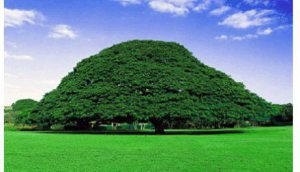



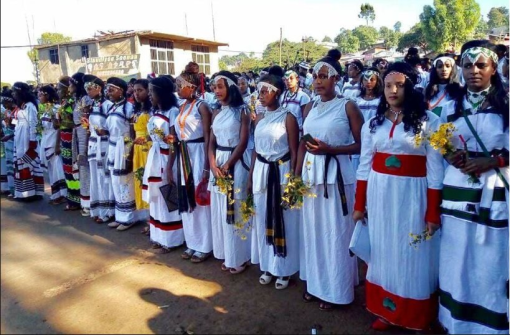































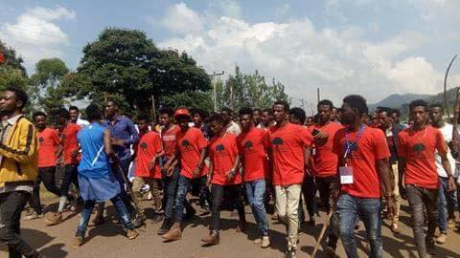









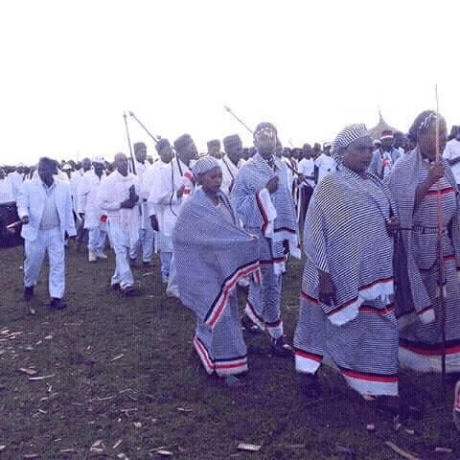
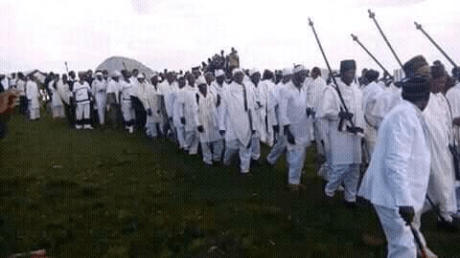



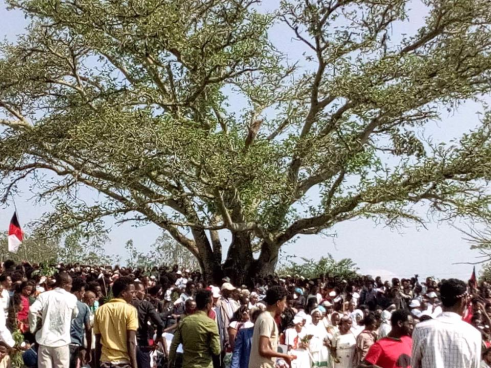
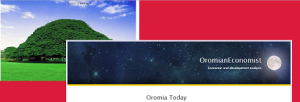
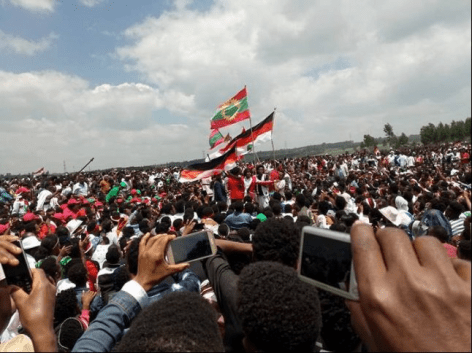
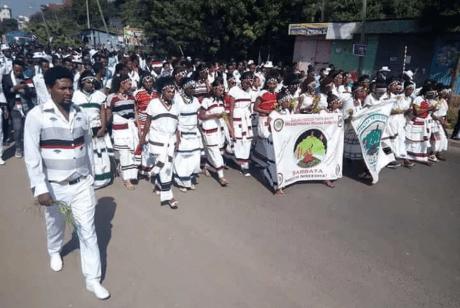

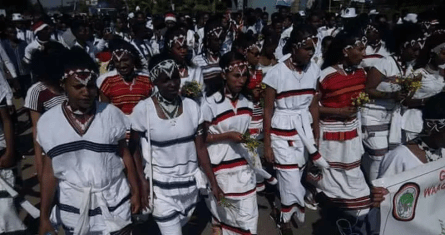
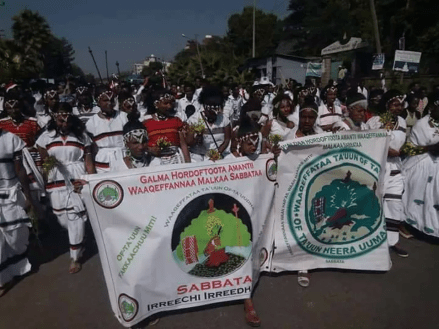
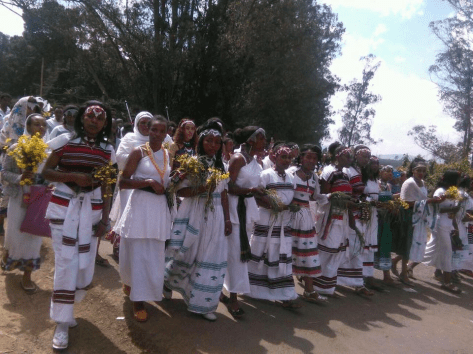

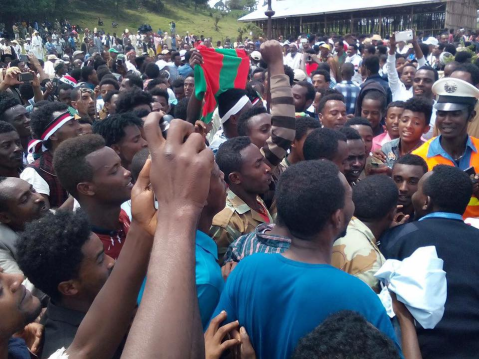
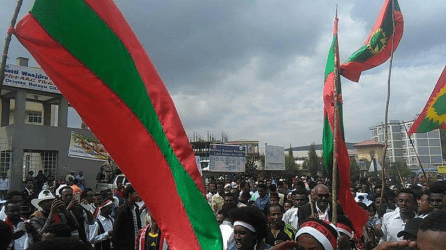

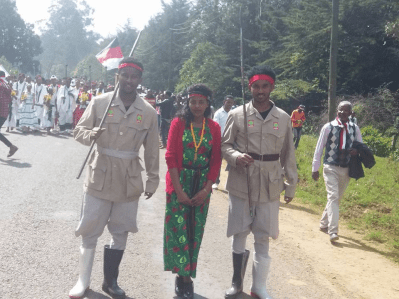
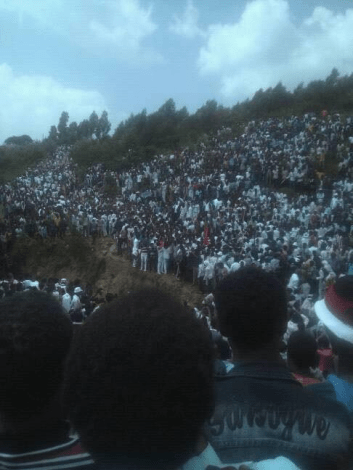
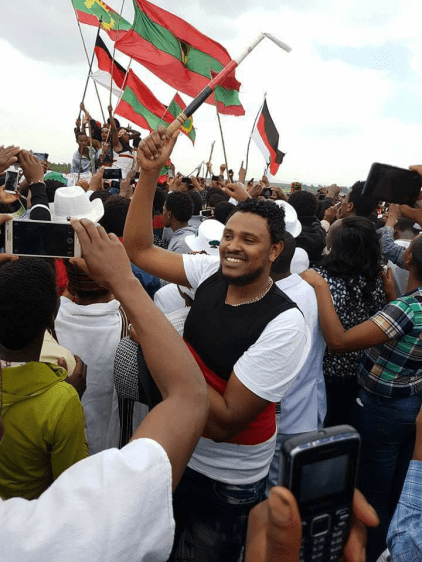
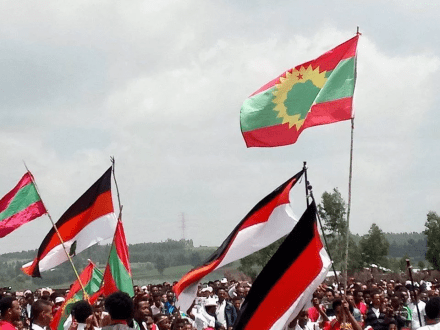
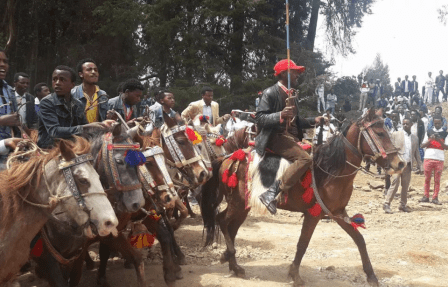
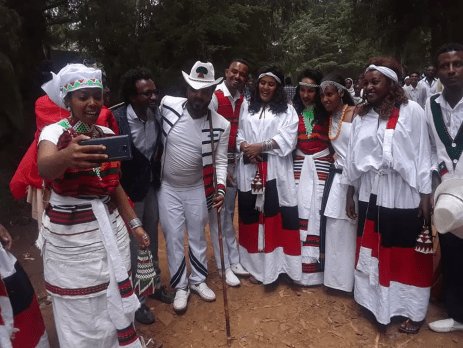
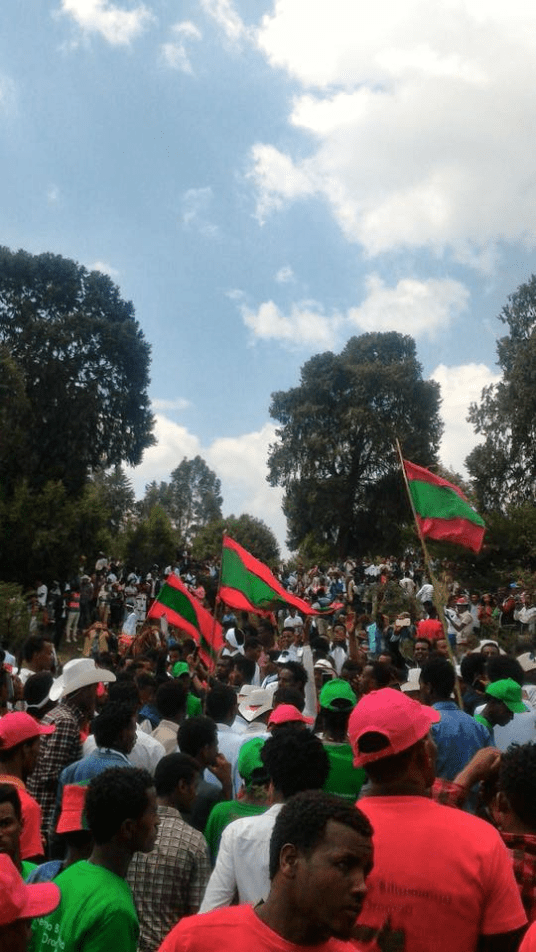
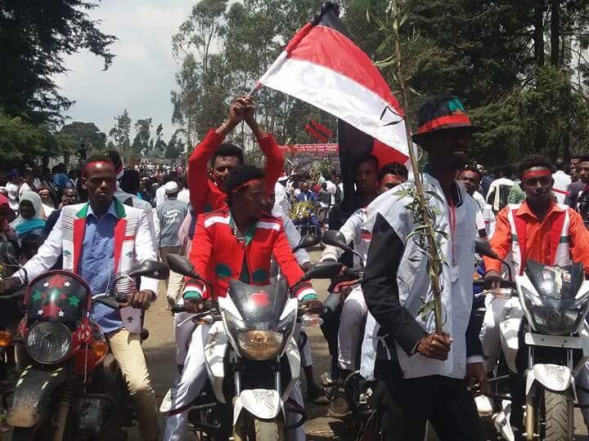
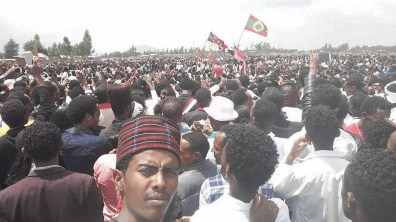
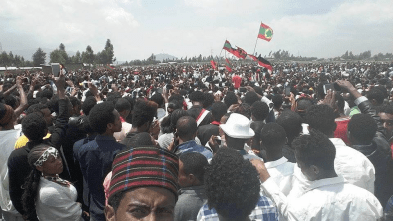

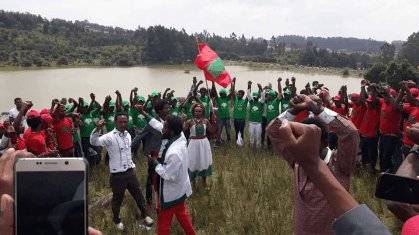




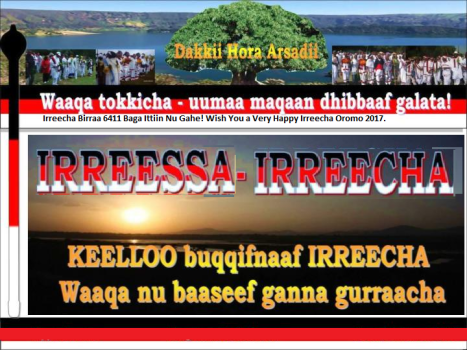
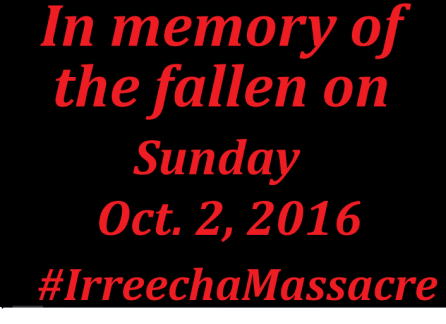
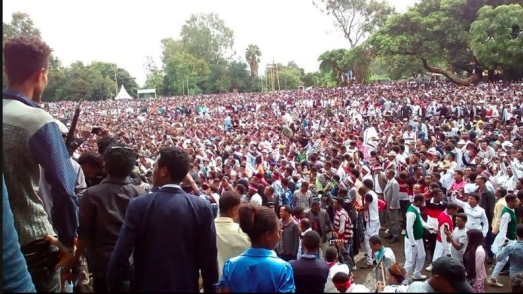
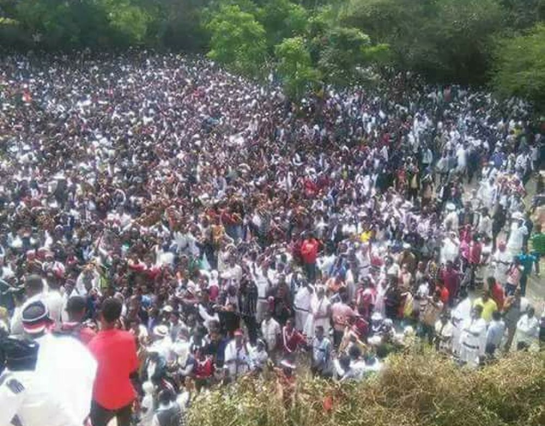

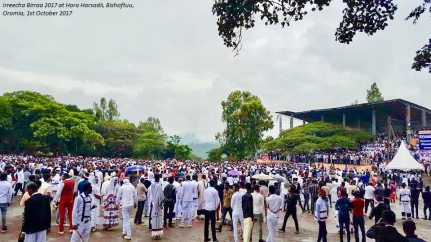
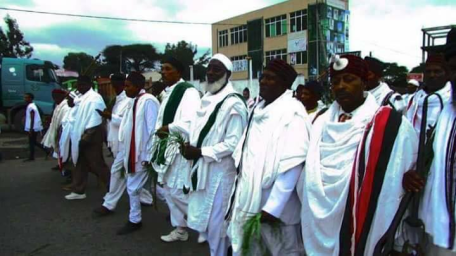

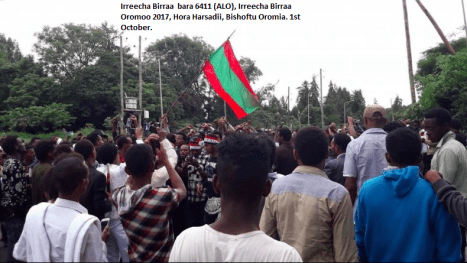


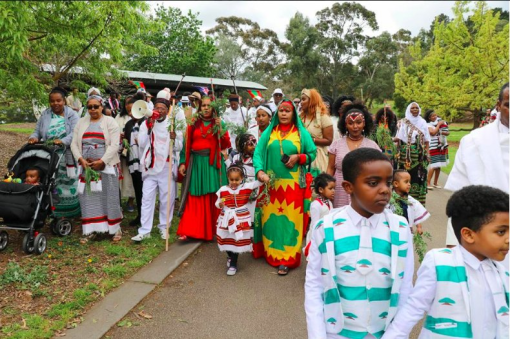
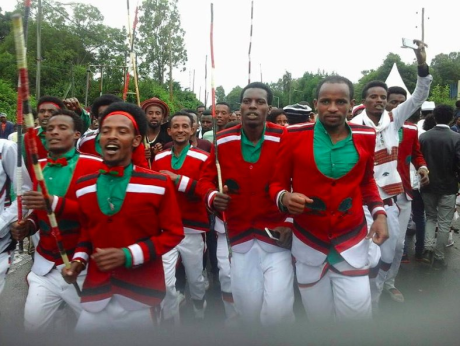

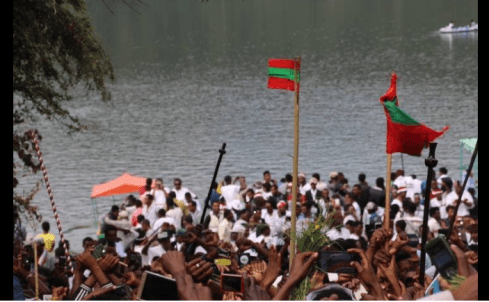

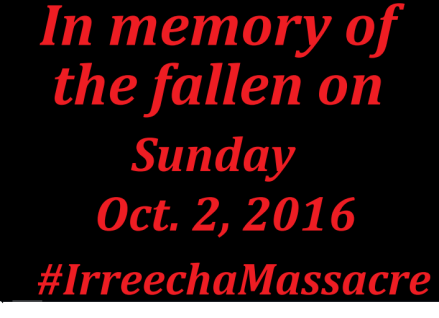
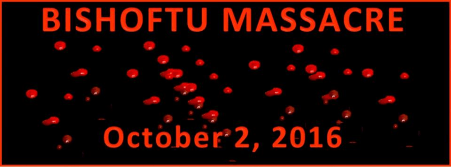
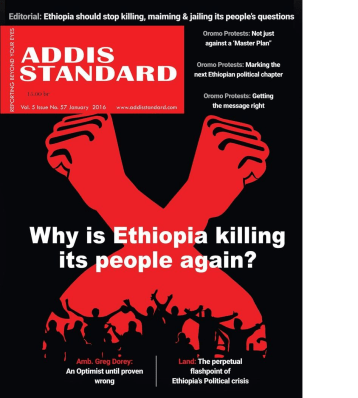


























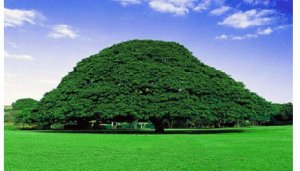
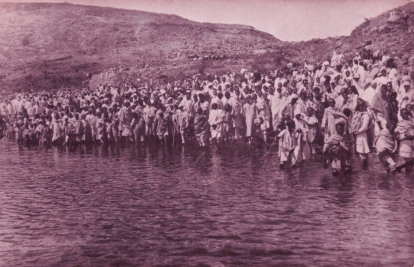
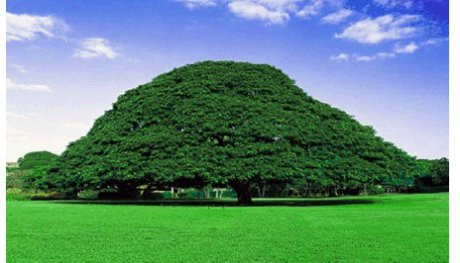
You must be logged in to post a comment.